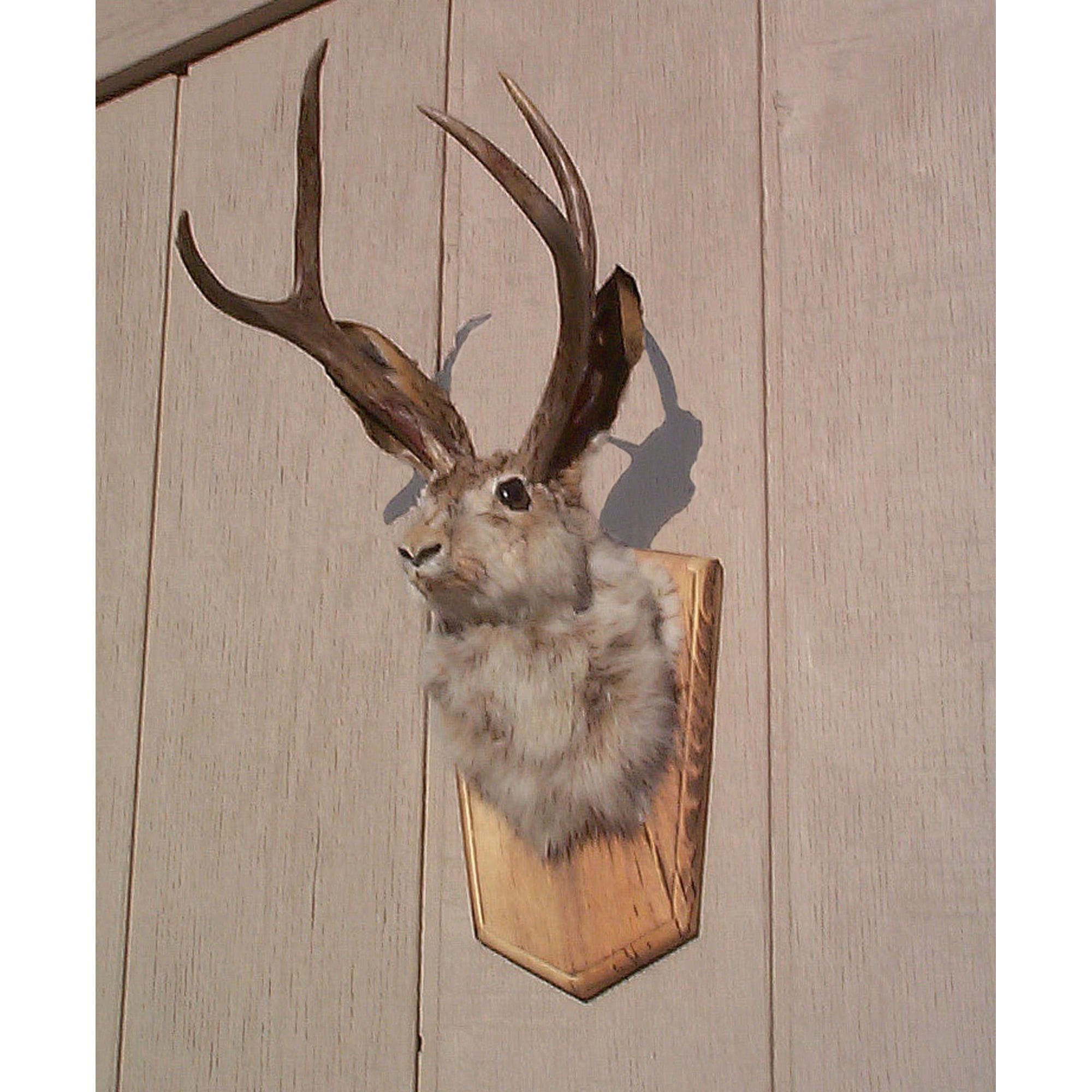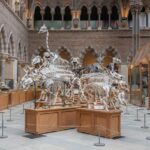Ever dreamt of owning a piece of the Wild West’s whimsical folklore? A creature that embodies the spirit of tall tales and taxidermy ingenuity? Look no further than the jackalope mount – a quirky, captivating piece of Americana that’s sure to spark conversations and add a touch of the extraordinary to any space. This guide dives into the world of jackalope mounts, exploring their history, the various types available, where to find them, and even how to craft your own. So, saddle up and prepare to explore the curious world of the jackalope!
Decoding the Jackalope Mount: Styles & Selection
Ready to bring a bit of the mythical West into your home? The first step in your jackalope quest is understanding the diverse range of mounts available. It’s like choosing a breed of dog – each with its own unique charm and personality.
Faux Taxidermy: The Kindest Cut
For animal lovers and those seeking a cruelty-free option, faux taxidermy is the perfect choice. Crafted from resin, plastic, 3D-printed materials, or even fabric and wood, these mounts offer a vibrant and imaginative take on the jackalope. Picture a neon pink jackalope striking a yoga pose, or a miniature, glittery one perched on a tiny cactus. The possibilities are as boundless as a prairie sky! Faux mounts are generally more affordable than traditional taxidermy, ranging from $10 for a small trinket to $150 or more for elaborate, handcrafted pieces. You can find a plethora of options on Etsy and Alibaba, as well as in craft stores.
Traditional Taxidermy: A Classic with Caveats
For a more classic approach, traditional taxidermy mounts, using real rabbit hides and deer antlers, offer a touch of vintage charm. However, it’s crucial to ensure any animal products used were sourced ethically and legally. Laws regarding the sale and possession of wildlife parts vary, so do your research before purchasing. Traditional mounts are often found on eBay and in specialty shops, starting around $100 and increasing in price depending on the quality and rarity.
Artisan-Crafted Mounts: Where Art Meets Myth
For a truly unique piece, consider an artisan-crafted jackalope mount. These one-of-a-kind creations, carved from wood, sculpted from clay, or forged from metal, are miniature works of art that celebrate the jackalope’s whimsical nature. Prices range from $50 to $500+, reflecting the time, skill, and artistry involved. Etsy, art galleries, and art fairs are excellent places to discover these treasures.
Beyond the Head: Exploring Jackalope Accoutrements
While the classic head mount reigns supreme, the jackalope’s influence extends beyond the traditional. Explore full-body mounts, wall hooks, quirky lamps, and even jackalope-themed jewelry. Unleash your creativity and embrace the unexpected! These unique items can be found on Etsy, Alibaba, and in various gift shops, with prices varying widely depending on the item and craftsmanship.
Tracking Down Your Trophy: Where to Buy a Jackalope Mount
Now that you’ve explored the diverse world of jackalope mounts, where do you actually find these elusive creatures? Luckily, they’re a bit easier to track down than their mythical counterparts.
Etsy: A treasure trove of handcrafted and vintage items, Etsy is the perfect hunting ground for unique, artisan-made jackalope mounts. Prepare to discover a wide range of styles and prices, with some truly exceptional pieces commanding a premium.
eBay: For bargain hunters and collectors, eBay offers a mix of new and vintage jackalope mounts, from mass-produced items to rare collector’s pieces. Sharpen your bidding skills and keep an eye out for those hidden gems!
Alibaba: If you’re on a budget, Alibaba provides a vast selection of mass-produced jackalope mounts at lower price points.
Specialty Taxidermy Shops (like All-Taxidermy.com): For traditional taxidermy mounts or high-end, custom-made creations, consult specialty shops. They offer expert craftsmanship but often come with a higher price tag.
Unveiling the Legend: The Story of the Jackalope
Before you bring home your very own jackalope, it’s worth understanding the origins of this mythical creature. While jackalopes don’t actually roam the prairies, their legend is a captivating blend of folklore, tall tales, and human ingenuity. Some believe the myth originated from sightings of rabbits infected with the Shope Papilloma Virus, which causes horn-like growths. Others attribute it to the tall tales spun by frontiersmen. Regardless of its true origin, the Herrick brothers of Douglas, Wyoming, played a pivotal role in popularizing the jackalope in the 1930s with their taxidermy creations. Their work cemented the jackalope’s position in American folklore and inspired countless interpretations.
Crafting Your Own Cryptid: DIY Jackalope Mounts
Feeling crafty? Why not create your own jackalope mount? It’s a fun and rewarding project. If you’re working with real animal parts, remember to source them ethically and legally. Alternatively, explore faux materials like polymer clay, craft foam, or even cardboard. Numerous online tutorials offer guidance for both seasoned crafters and beginners. Delve into the rhythmic depths of poetry to find inspiration with our sophisticated iambic pentameter checker.
The Price of Myth: How Much Does a Jackalope Mount Cost?
The cost of a jackalope mount varies widely based on the type of mount, materials used, size, and craftsmanship. Here’s a general price guide:
| Type of Mount | Price Range | Where to Look |
|---|---|---|
| Faux Taxidermy | $10 – $150+ | Etsy, Alibaba, Craft Stores |
| Traditional Taxidermy | $100+ | eBay, Specialty Shops |
| Artisan Crafted | $50 – $500+ | Etsy, Galleries, Art Fairs |
| Other (hooks, etc.) | Varies widely | Etsy, Alibaba, Gift Shops |
Preserving the Legend: Caring for Your Jackalope Mount
Once you’ve acquired your piece of jackalope lore, proper care will ensure its longevity. Dust regularly with a soft cloth, avoid direct sunlight to prevent fading, and, if you have a traditional taxidermy mount, consult a professional taxidermist for specific cleaning and preservation advice. Treat your jackalope mount with respect; it’s a tangible piece of American folklore.
Separating Fact from Fiction: Is the Jackalope Real?
Let’s address the burning question: are jackalopes real? While they capture our imaginations, jackalopes, as antlered rabbits hopping across the prairie, don’t exist in the wild. They are a product of human creativity, not natural evolution. The tale began in the 1930s with two Wyoming brothers, Douglas and Ralph Herrick, who combined taxidermy skills with a playful spirit. Their creation sparked a phenomenon, spreading through postcards and souvenirs, and culminating in “Jackalope Days” in Douglas, Wyoming.
While the Herrick brothers popularized the jackalope, the concept of horned rabbits appears in various cultures’ folklore, from a single-horned rabbit in 13th-century Persia and historical texts to Bavaria’s antlered and winged Wolpertinger, adding an intriguing historical dimension to the jackalope myth.
Adding a touch of biological intrigue to the jackalope story, there is the Shope Papilloma Virus, a virus that causes horn-like growths on rabbits. It makes you wonder whether this virus influenced the jackalope myth or simply adds another layer of mystery.
The jackalope isn’t a creature of the wild, but its impact on popular culture is undeniable. It symbolizes creativity, storytelling, and the power of imagination. Explore the fascinating world of coding with Jay Ostrem for another example of creativity and ingenuity.
Has a Jackalope Ever Been Found?
No explorer has ever documented a real jackalope roaming the wild. Like Bigfoot or the Loch Ness Monster, the jackalope resides in the realm of myth and legend. It sprang not from the wilderness but from the ingenuity of the Herrick brothers in their 1930s Wyoming taxidermy shop. Their whimsical creation captured imaginations, becoming an emblem of the American West. Douglas, Wyoming, has even tried to make the jackalope its official state symbol.
Jackalopes are found not in nature but in the rich tapestry of American culture. From roadside attractions and novelty shops to its enduring presence in Douglas, Wyoming, which has erected statues and even hosts festivals in its honor, the jackalope’s charm lies in its sheer absurdity, reminding us to embrace the whimsical.
Interestingly, horned rabbits exist in folklore and historical records predating the modern jackalope. 13th-century Persian illustrations and Bavarian folklore’s Wolpertinger, along with descriptions in historical texts like Historiae Naturalis de Quadrupetibus, of horned rabbits, add a historical depth to the jackalope myth.
| Feature | Jackalope | Jackrabbit | Antelope |
|---|---|---|---|
| Existence | Mythological | Real | Real |
| Horns | Yes (added) | No | Yes |
| Habitat | Folklore, Souvenirs | Grasslands, Deserts | Plains, Open Woodlands |
| Origin | Douglas, Wyoming, 1930s | North America | Various regions globally |
| Cultural Role | Legend, Symbol of whimsy | Part of ecosystem | Game animal, Symbol of grace |
This table clearly distinguishes the jackalope as a unique creation existing solely in our imaginations.
Douglas, Wyoming: The Jackalope Capital of the World
Douglas, Wyoming, proudly claims the title of “Jackalope Capital of the World,” fully embracing the legend and intertwining it with the town’s identity. The town is a jackalope haven, featuring statues of all sizes (including what’s probably the world’s largest), and shops filled with jackalope memorabilia. Douglas isn’t just a place to find jackalopes; it’s their spiritual homeland, celebrating them with festivals and local pride.
| Feature | Description |
|---|---|
| Official Title | Jackalope Capital of the World |
| Location | Douglas, Wyoming |
| Origin of Legend | Herrick brothers, 1930s, taxidermy shop |
| Notable Attractions | World’s largest jackalope statue, numerous smaller statues, jackalope silhouette overlooking town |
| Cultural Significance | Town mascot, festivals, souvenirs, local pride |
| Possible Real-World Link | Shope papillomavirus causing horn-like growths in rabbits |
| Trademark Status | Wyoming trademarked “Jackalope” in 1965. |
While the jackalope remains firmly in the realm of myth, its cultural impact, particularly in Douglas, Wyoming, is undeniable. This information reflects the accepted narrative and cultural significance of the jackalope. While research may explore folklore’s connection to natural phenomena, the jackalope’s place in our hearts is secure.
- Unlocking TEA Words: Comprehensive Analysis & Lexical Insights - April 29, 2025
- Unlock Sustainable Farming:Achievable Crop Yields Now - April 29, 2025
- Unlock Your Potential: Words With Inspiration for Lasting Success - April 28, 2025
















